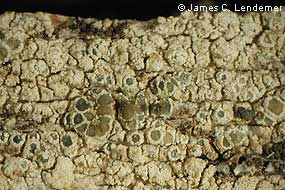|
You are viewing ARCHIVED content published online before January 20, 2025.
Please note that this content is NOT UPDATED, and links may not work. For current information,
visit https://www.nps.gov/aboutus/news/index.htm.
Contact: John C. Cannon, 415-464-5221

A team of scientists collecting lichens at Point Reyes National Seashore in July discovered a species that was unknown to science until now. Led by Lawrence Glacy, Larry St. Clair of Bringham Young University, and Tom Nash of Arizona State University, the group was surveying lichen diversity in the park as part of a fieldtrip that preceded the sixth meeting of the International Association of Lichenologists, which occurred from July 13 to July 19, 2008 in Pacific Grove, California. Kerry Knudsen, a lichenologist at the University of California, Riverside, took a sample of this new species from a wooden fence near the Bear Valley Visitor Center. Lecanora simeonensis, as it will be known, similarly inhabits dry wood in other areas of coastal California, including San Simeon State Park near San Luis Obispo. Knudsen and his colleague, James C. Lendemer of the New York Botanical Garden, aim to publish a research paper in the spring, detailing the unique characteristics of this species and two others that live in California. Wispy, plant-like lichens can be found draped on tree branches throughout the park, and are actually made up of a fungus and (typically) an alga that symbiotically coexist. The fungi absorb minerals and water from the wood, which the alga in turn uses to produce energy photosynthetically—that is, by converting the sun’s light into energy-rich carbohydrates—for both itself and the fungi. Without a root system, lichens depend on absorbing necessary nutrients from the air. For this reason, lichens are particularly sensitive to air pollution, and have been used as bio-indicators in studies assessing air pollution. Twenty-four lichenologists attended the diversity survey at Point Reyes, including Judy and Ron Robertson of the California Lichen Society, which promotes the study and conservation of lichens in California and the western United States. Additional participants included scientists from Thailand, Japan, United States, England, Finland, Mexico, Russia, Poland, Estonia, the Czech Republic, and Germany. This new discovery—and perhaps others, as scientists who partook in the fieldtrip continue to analyze the samples they collected back in there home laboratories in nearly a dozen countries worldwide—will add to the growing database of knowledge being gathered by the National Park Service’s All Taxa Biodiversity Inventories. This project, which involves Point Reyes National Seashore and the Point Reyes National Seashore Association, is a national collaboration with many universities, governmental agencies and 8 other national parks across the country. The goal is to benefit not only scientists and park managers, but also the public through science-based interpretive programs. For more information, contact Ben Becker, Director and Marine Ecologist, Pacific Coast Science and Learning Center, Point Reyes National Seashore at 415-464-5247. -NPS- |
Last updated: February 28, 2015
